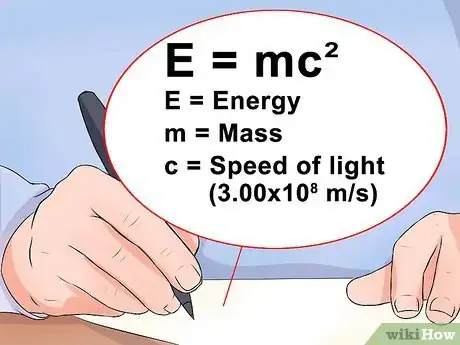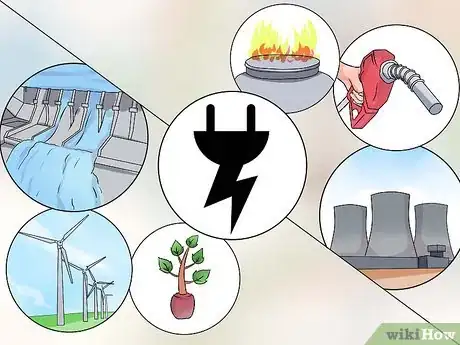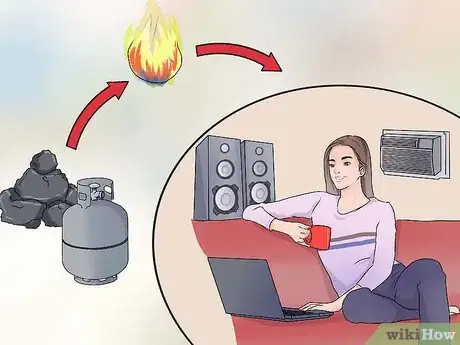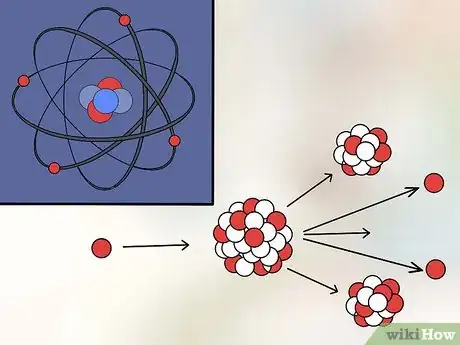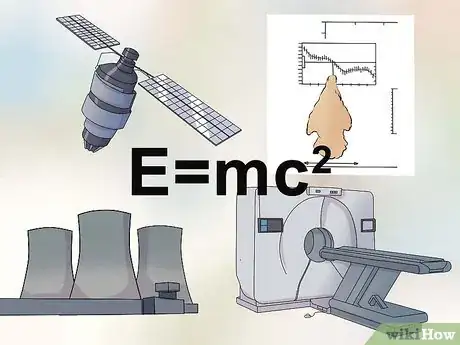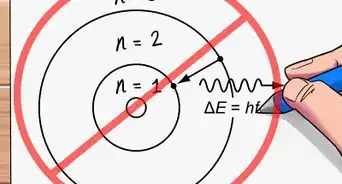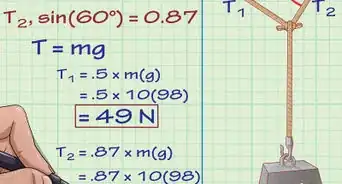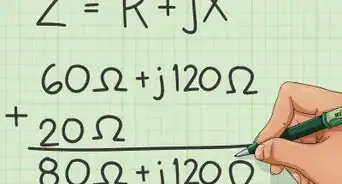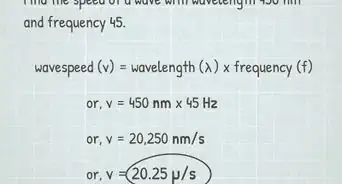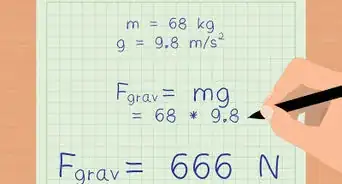wikiHow is a “wiki,” similar to Wikipedia, which means that many of our articles are co-written by multiple authors. To create this article, 56 people, some anonymous, worked to edit and improve it over time.
There are 7 references cited in this article, which can be found at the bottom of the page.
wikiHow marks an article as reader-approved once it receives enough positive feedback. This article received 54 testimonials and 83% of readers who voted found it helpful, earning it our reader-approved status.
This article has been viewed 1,178,525 times.
Learn more...
In one of Albert Einstein’s revolutionary scientific papers published in 1905, E=mc2 was introduced; where E is energy, m is mass, and c is the speed of light in a vacuum.[1] Since then, E=mc2 has become one of the most famous equations in the world. Even people with no background in physics have at least heard of the equation and are aware of its prodigious influence on the world we live in. However, most people do not exactly know what the equation means. In simple terms, the equation represents the correlation of energy to matter: essentially, energy and matter are but two different forms of the same thing.[2] This relatively simple equation has altered the way we think about energy and provided us with numerous technological advances.
Steps
Understanding the Equation
-
1Define the variables of the equation. The first step to understanding any equation is to know what each variable stands for. In this case, E is the energy of an object at rest, m is the object's mass, and c is the speed of light in vacuum.[3]
- The speed of light, c is constant in all reference frames and is roughly equal to 3.00x108 meters per second. In the context of Einstein's relativity, the c2 functions more as a unit conversion factor than a constant. As such, it is squared as a result of dimensional analysis - energy is measured in joules, or kg m2 s-2, so adding the c2 ensures that the relationship between energy and mass is dimensionally consistent.
-
2Understand what is meant by energy. There are many forms of energy including thermal, electrical, chemical, nuclear and more.[4] Energy is transferred between systems giving power to one system while taking it away from another.
- Energy can be neither created nor destroyed, it can only take a different form. For example, coal has a lot of potential energy that turns into thermal energy when it is burned.
Advertisement -
3Define what mass means. Mass is generally defined as the amount of matter in an object.[5]
- There are also a few other definitions of mass. There exists "invariant mass," and "relativistic mass." Invariant mass is mass that remains unchanged no matter what frame of reference you are in. Relativistic mass, on the other hand, depends on the object's velocity. In the equation E = mc2, m refers to the invariant mass. This is very important, because this means that your mass does not grow as you go faster, contrary to popular belief.
- It’s important to understand that mass and weight are different. Weight is the gravitational force felt by an object, while mass is the amount of matter in that object. Mass can only change if the object is physically altered, while weight changes depending on the gravity of the environment the object is in. Mass is measured in kilograms (kg) while weight is measured in newtons (N).
- Like energy, mass can neither be created nor destroyed, but it can also change form. For example, an ice cube can melt into a liquid, but it still has the same mass in both states.
-
4Realize that mass and energy are equivalent.[6] The equation states that mass and energy are the same thing and tells you how much energy is contained inside a certain amount of mass. Essentially, the equation explains that a small amount of mass is full of a large amount of energy.
Applying the Equation in the Real World
-
1Understand where usable energy comes from. Most of our consumable energy comes from the burning of coal and natural gas. Burning these substances takes advantage of their valence electrons (unpaired electrons in the outermost shell of an atom) and the bonds they make with other elements. When heat is added, these bonds break and the energy released is used to power our communities.
- Obtaining energy this way is not very efficient and is costly to the environment.
-
2Apply Einstein’s equation to make energy conversion more efficient. E=mc2 tells us that there is much more energy stored inside the nucleus of an atom than in its valence electrons. The energy released from splitting an atom is much higher than that of breaking electron bonds.
- Nuclear power is based on this principle. Nuclear reactors cause fission (the splitting of atoms) to occur and capture the massive amount of energy released.
-
3Discover the technologies made possible by E=mc2. E=mc2 has enabled the creation of many new and exciting technologies, some of which, we can’t imagine living without:[7]
- PET scans use radioactivity to see inside the body.
- The equation allowed for the development of telecommunications with satellites and rovers.
- Radiocarbon dating uses radioactive decay based on the equation to determine the age of ancient objects.
- Nuclear energy provides cleaner and more efficient energy sources to our society.
Community Q&A
-
QuestionIf mass can neither be created nor destroyed as stated in your article, can mass change into energy and vise versa?
 Community AnswerEinstein is basically saying that mass and energy are different forms or descriptions of the same thing. By converting mass to energy, you are still conserving the mass through the form of energy.
Community AnswerEinstein is basically saying that mass and energy are different forms or descriptions of the same thing. By converting mass to energy, you are still conserving the mass through the form of energy. -
QuestionYou use a melting ice cube as an example of an object changing forms without losing mass. But surely the melted water will occupy less volume than the ice cube?
 Community AnswerMass and volume are not the same. You can stretch or compact an object to change its volume, but the amount of matter inside it will stay the same. In the ice cube example, the molecules in liquid water are closer together, but they're still the same molecules that were in the ice.
Community AnswerMass and volume are not the same. You can stretch or compact an object to change its volume, but the amount of matter inside it will stay the same. In the ice cube example, the molecules in liquid water are closer together, but they're still the same molecules that were in the ice. -
QuestionCan humans travel 1% the speed of light yet?
 Community AnswerNo, not even close. Keep in mind that the speed of light is 3.00×10^8 meters/second. For us to even go a fraction of that speed, 1% for example, we would have to go 3.0×10^6 meters/second which is approximately 1,864.1 miles/second or 6,710,808.88 miles/hour. We are not even close to that speed yet technologically.
Community AnswerNo, not even close. Keep in mind that the speed of light is 3.00×10^8 meters/second. For us to even go a fraction of that speed, 1% for example, we would have to go 3.0×10^6 meters/second which is approximately 1,864.1 miles/second or 6,710,808.88 miles/hour. We are not even close to that speed yet technologically.
References
- ↑ https://www.amnh.org/exhibitions/einstein/energy/e-mc2
- ↑ http://www.universetoday.com/114617/a-fun-way-of-understanding-emc2/
- ↑ https://www.amnh.org/exhibitions/einstein/energy
- ↑ http://www.emc2-explained.info/Emc2/Basics.htm#.Vhv1WvlViko
- ↑ http://www.emc2-explained.info/Emc2/Basics.htm#.VhxJCPlVikp
- ↑ http://www.pbs.org/wgbh/nova/einstein/expe-text.html
- ↑ http://www.pbs.org/wgbh/nova/physics/legacy-of-e-equals-mc2.html
About This Article
To understand E=mc², you have to define each of the variables. E is the energy of an object at rest, m is that object’s mass, and c is the speed of light in a vacuum. Neither the energy nor the mass of an object can change, although the mass can change forms, such as when an ice cube melts. The purpose of the equation is to tell you how much energy is contained in a certain amount of mass. To learn how to apply the equation to the real world, read on!
